Introduction
This is the ninth article in my Business Architecture Essentials series. To date we have tackled business ecosystem dynamics, stakeholder and strategy issues as well as establishing a number of foundational architectural models that organize our work and our assets, tangible and otherwise. In the last article I dealt with the tricky topic of performance measurement and structural performance motivation. Without the structured models as a baseline and strategic intentions and measurement of performance in place, it is impossible to develop a portfolio of change other than one based on personal opinions and internal politics. This article is intended to leverage all of the knowledge we have gained by applying the methods of the previous articles to establish a set of high-level priorities that will deliver the best changes; ones that allocate our scarce financial and human resources towards the best return based on a repeatable strategic and architectural method as seen in Figure 1. In this article I will take on a fast and overall approach to prioritization. It will deal with establishing priorities based on business strategic importance and process performance gaps at a high level . This will be the starting point for a more comprehensive approach in the next article that also deals with the resource allocation issue and the connection between processes and capabilities. The next article will tackle the choices of which specific capabilities and resource changes are needed to deliver against the best choice business rationale. It will end with a transformation roadmap.
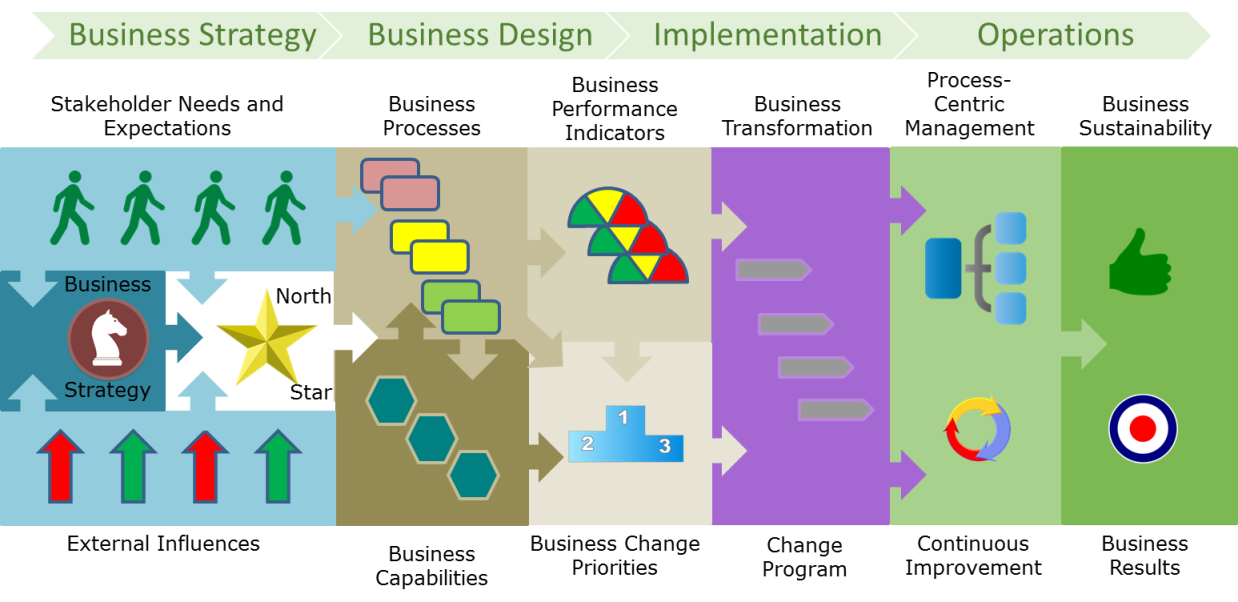
Figure 1

Everything we have dealt with so far in the series has been focussed on two main types of business knowledge. The first is aimed at understanding the drivers for business operations in terms of the business ecosystem, business intent and strategy as dictated by the world that the business is part of and our stakeholders in that world. This reflects our choices in what we would want to become as a business based on what we know about our world and our self. It does not, however, prescribe what we should do differently or what to build so that we are capable of doing it. It does provide us with a set of consistent criteria that we can and should use to choose among investment alternatives of which there are many.
The second knowledge set is the heart of the business architecture in terms of the components of the knowledge base that describe how we are currently and wish to be structured to deal with the intentions and operation of the business day to day. It also deals with the assets, physical and others, that we will need to move to a renewed state. Intelligently matching the knowledge assets we have gained against the intentions and business strategy will provide us with a sound investment strategy that maximizes the business value of our spend and most expeditiously gets us to our goal state.
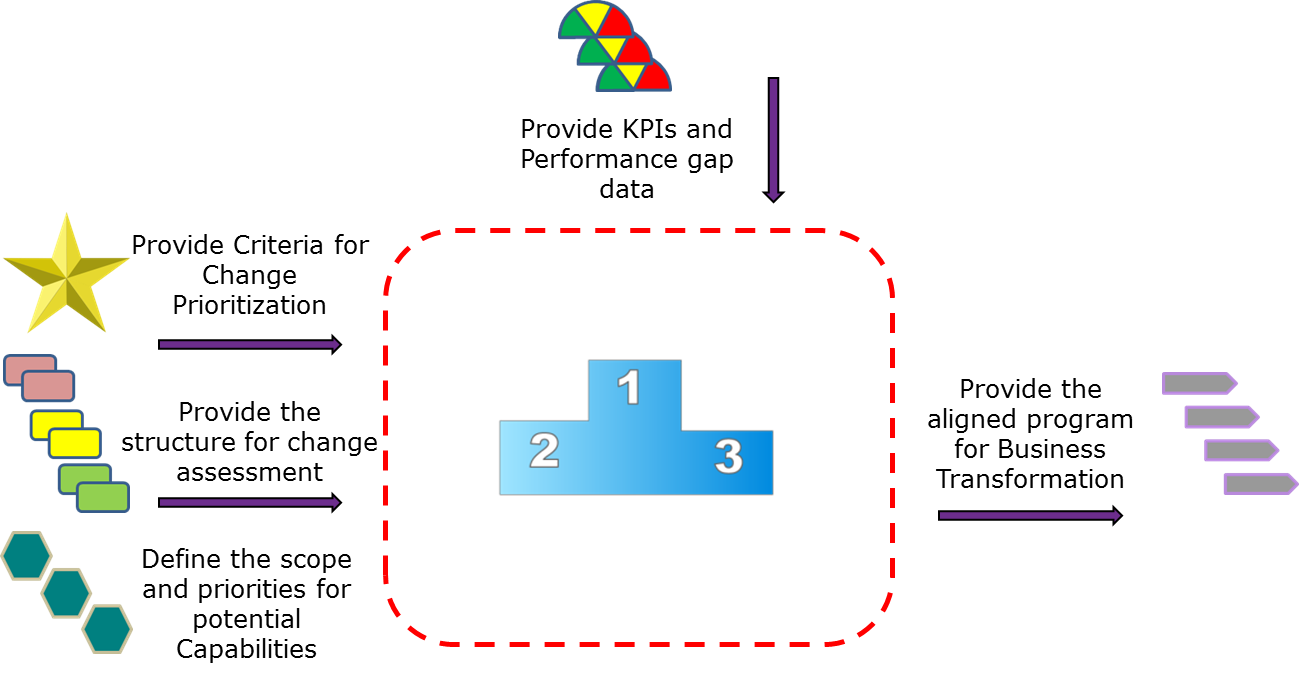
Because market conditions change constantly and required resources are not sitting around waiting to be assigned ,this assesment is critical to conduct periodically in as small a repeating cycle as is reasonable. At a minimum, it should be done in sync, meaning slightly before or iteratively with, the annual portfolio management and budget timings. Ideally, it will be done more often perhaps on a quarterly basis as the real world races by and perpetual ecosystem changes and reality of the status of changes underway become apparent to us.
Structure of Change Prioritization: Processes or Capabilities First?
There are some choices regarding the primary organization or structuring mechanism of planning for change. The two most common are business capabilities and business processes as the hub. Strong arguments can be made for each and at the end of the day we have to have plans to change each and also to determine which specific resources will require efforts to renew them. So it’s not one or the other but both.
The argument for a capability led approach, typically made by Enterprise Architects, is that ultimately we have to plan for and make changes in capabilities so get right at it and define and correct any weaknesses directly without having to deal with business operations per se. The argument for business processes is that operational work is what we execute every day and it has to be changed in order to enhance performance. Processes get measured in business terms and we want to improve that business performance. They are what our customers and other stakeholders experience directly or are impacted by. We have to determine how our processes interact with stakeholders on the outside world as the prime concern. Processes and capabilities are co-dependant of course and processes require capabilities to be applied to deliver better business performance and relationship outcomes, however, customers only realize our capabilities (good or bad) when process work is done. The ultimate goal of our architecture efforts must be to end up with more effective and efficient business operations that are inherently adaptable. This is the view of business operational managers who are accountable for measurable results. For this reason I will pursue a process first approach that will focus on operational business performance as the means to determine which capabilities are deserving of priority enhancement and investment compared to possible alternatives. This will be the subject of article 10.
So in summary
- Capabilities do not uniquely act directly to deliver performance of operations – only when they are employed by processes
- Many capabilities are needed by more than one process.
- End to end processes are tied to performance and capabilities provide the ability for them to perform. Large process performance gaps imply large capability gaps.
- Realization of Strategic Intent is measurable when delivered through processes in action. They become a logical place to look at first to ensure traceability to overall objectives.
- However, capabilities which are often described as at rest provide the potential for processes to perform. I showed in an earlier article that a process requires several capabilities to be available but each of the capabilities that it is dependent on may also support multiple processes so looking at both is essential to avoid unintended consequences.
- We will start with processes and connect to capabilities in a symbiotic way next time.
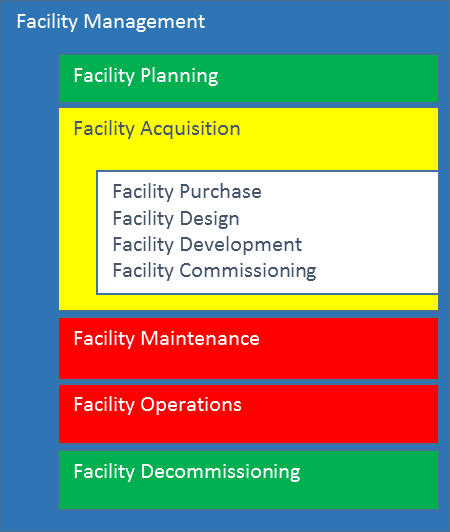
Fixing weak capabilities without knowing which processes employ them does not guarantee better net business performance or attainment of strategic intent. Non-strategic capability weaknesses may be quite acceptable and not be a problem. Strategic considerations of inherent value contribution must be examined to avoid investing in the unimportant. If we use the example of a 100% online bank and we assessed its Facility Management capability we might find that several sub capabilities are weak but just going after them without the performance context does not help since in this scenario bricks and mortar banking branches are irrelevant to our mission and vision. It is not enough to look solely at capabilities. Capabilities in the context of processes and performance priorities will serve us better.
Resource Allocation Criteria: Reviewing Strategy and the North Star
In article 3 ‘Defining your External Stakeholders: Interactions, Value, and Performance’ and 4 ‘Synthesizing your Architecture’s Strategic Guidance’ we discussed the requirements for stakeholder relationship optimization and striving towards the strategic intent of the organization as the purpose of all architecture work.
Some highlights of those articles that we need to be conscious of here follow.
 Strategic Intent
Strategic Intent
It is essential that we have a common and unwavering focus on the strategic intent of the business so that our enterprise understands what success looks like. A well-formed set of strategic intent attributes is comprised of the following.
External Stakeholder Analysis
With such strong attention today on how our enterprise plays in our ecosystem, the focus on the customer relationship, journey and experience is essential. Digital strategies are pointless without these. However, customers are among the wide set of external parties with which our enterprise must interact in order to exist and thrive. We have to understand all of them and create a balance among the conflicting expectations of each. Critical stakeholder knowledge includes the following characteristics.
- A recognition of the style of customer relationship that should pervade all planning thinking: the Value Proposition with its classic choices of Operational Excellence, Customer Intimacy and Innovation will help us choose among investment choices and design needs.
- Understanding who the stakeholders of note are is essential: who cares about us and who do we care about?
- We must know what’s happening at the ends: what tangible or virtual exchanges do we have with outsiders?
- Being clear on what expectations we have of others and them of us is a must: what value and experience is expected by both parties in each relationship?
- We need to know what measurement indicators can be used to evaluate stakeholder relationship performance and what are the gaps between current state and future objectives?
- We must be aware of what aspects of the relationship are unhealthy.
- We should know what are the required capabilities for relationship success.
If we have not done this investigatory work earlier we must do it now: criteria before decisions.
The Consolidation of Strategic Intent and Stakeholder Analysis: The North Star
There are a myriad of opinions on what priorities should be. Unfortunately these are often based on individual groups or executive’s functional roles and performance motivations. Going with an opinion based approach is a minefield and rarely results in what’s best for operational business results. That’s why we tackled the thorny issue of gaining acceptance to the strategic and stakeholder criteria for end to end outcomes as a basis for choosing among alternatives earlier in the architecture before we started to prioritize investments here. This allows architects, planners and business leaders to recommend a program of change that is outcome based and not divisional or functional in nature. If you recall, the North Star is a packaging of stakeholder analysis and strategy discussions that provides from four to seven weighted statements (aka goals) with vectors of increase, decrease or sustain to indicate the needed movement. It also has weighting factors to show the relative importance of each criterion. In Article 4 I showed the example of our own Company’s North Star

Reviewing Performance Gaps
Performance gaps indicate how far away we are from measured results targeted for the end of the planning horizon of the strategy work. This is a key point since the gap is not from where you are to where you should be today but to where you choose to aim for. There may not be a current gap today but a big one compared to the future.
If we had been diligent enough in the past we would have had all the performance data we needed, nicely relevant for each of the processes that we have architected. Perhaps at the end of our architecture journey, if there ever is one, we would have all of the measured performance statistics we need but that is a dream today in virtually every enterprise. Realistically we will have some relevant data and we should use it. We can run analytics to get whatever else we can derive or infer to help take away personal biases regarding performance. We will still be left, however, with relying on market feedback from the stakeholders themselves. This can come from customer service calls, social media chats and feedback from those on the front lines. This anecdotal source of success or dissatisfaction will still be essential for some time to come for most.
Fast Track Pain and Gain
As indicated earlier the place to place your investment bets are with those processes that potentially can deliver the highest stakeholder and strategic value (Highest Gain) and simultaneously are the worst performers today relative to what’s needed going forward (Highest Pain). High Pain and High Gain deserves our attention and our scarce resources. A comprehensive assessment of all of the factors is often not saleable in early days of business architecture, especially first time through. In this case, we recommend a fast tracked approach to prioritization based on a triaged approach whereby everything in the process architecture up to level 2 processes but not deeper for all core, guiding and enabling processes is assessed relative to one another.
Process Gain
 Using the North Star as a general reference point we would select the processes that potentially contribute the most versus the least and those in between. This is a triage since we try to assure that there are an equal number of processes in each zone. This is done while deliberately ignoring the performance gap of each process. We will get to that next. A poorly performing process is not necessarily important in and of itself. Strategic contribution by its nature is what we are looking for here
Using the North Star as a general reference point we would select the processes that potentially contribute the most versus the least and those in between. This is a triage since we try to assure that there are an equal number of processes in each zone. This is done while deliberately ignoring the performance gap of each process. We will get to that next. A poorly performing process is not necessarily important in and of itself. Strategic contribution by its nature is what we are looking for here
High contribution items will contribute most to the North Star and the customer value proposition. These are the ones that will differentiate us in the marketplace and make us distinctive compared to our competition. World class capability and performance is required in these. Medium contribution processes are those whereby we have to be at par with others in our industry or market space. Being worse will be noticed and will hurt us with our customers. They may not even notice superior performance here unless it is inferior. However, they will not value these any more if we were world class. It’s not that important to them. We just have to be best practice. Low contribution processes are not valued much by customers nor do they contribute much to marketplace success. If we are just adequate that’s not an issue. No one likes to hear that their work area is not the most important. All areas are important but excellence in some is more valuable than others. Note that this is a relative triage into more or less equal thirds and we force fit these to get a focus on attaining strategic intent and a focus on what matters most.
Process Pain
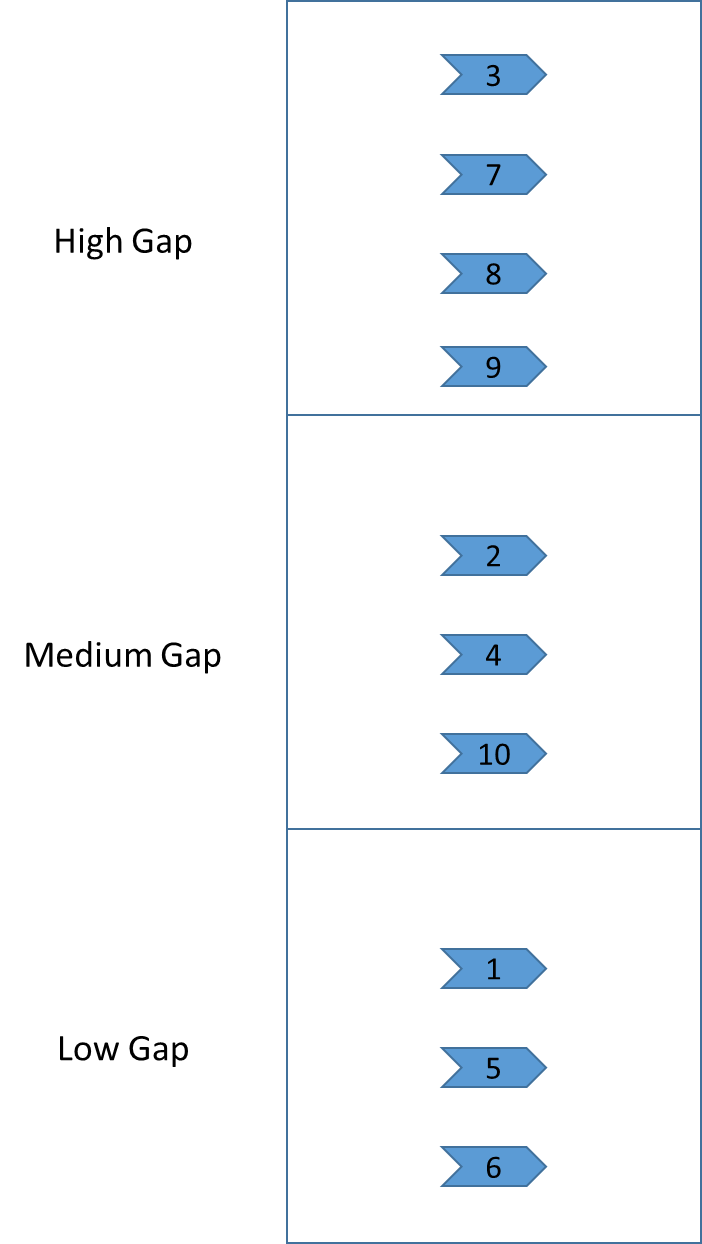
Likewise we will take the same processes and map them to the degree of performance gap they exhibit today compared to the future. As mentioned this can be achieved by comparing feedback from performance tracking or analytics or it can be anecdotal, whatever you can get your hands on.
When considering Pain we apply some established criteria to help formalize what otherwise could easily become a politicized exercise. Some senior staff want to gain investment into an area they care about so claim it is very badly broken. Others, for personal reasons, do not want others to see their areas as poorly performing so defend their turf and push away changes. We ask:
How well does the process currently achieve the defined Process Ideal Outcome(s)?
- Are the desired results of the process achieved now?
Is the process executed consistently by all performers?
- Is the process repeatable across the Enterprise or done differently by different groups and locations?
- Is the process formalized, that is structured and defined in a shareable way?
- Do people involved understand their role and responsibilities?
- Is there clear direction reference materials on what to do?
Are the resources efficiently utilized?
- Resources are not just human – technical, financial, etc
- Are resources over or under-utilized?
- Are resources efficiently utilized during normal and exception circumstances?
- Is the process efficient or is there wasted activity?
Mapping of Pain and Gain
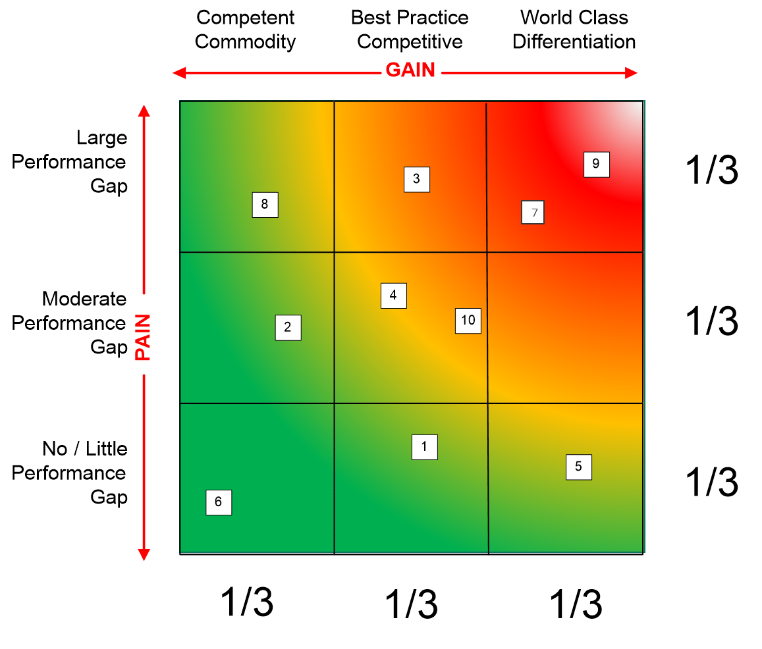
Combining these two perspectives will give us a process prioritization grid as illustrated.
This combines the two triage exercises into an actionable heat map that focusses on the optimal allocation of change resources with biggest bang for the buck. High Gain and High Pain is where the action should be. Once some other feasibility issues are considered we can now focus on the resource capabilities needed to invest in the right change. Program and develop our roadmap.
Article 10 will look at how the fast tracked priorities developed in this article will be examined and developed into a detailed plan for capability development and implementation and a roadmap for transformation.





